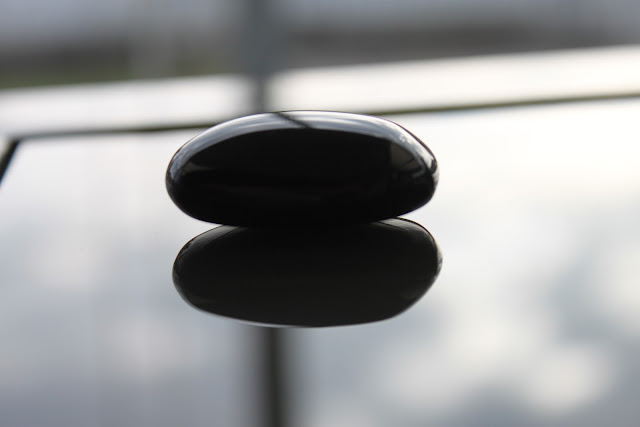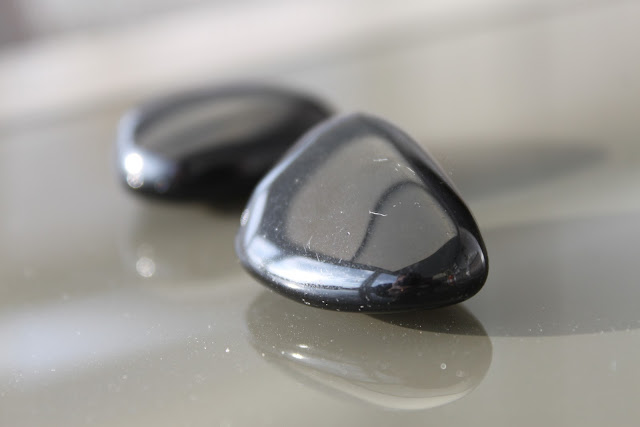Obsidian is a naturally occurring volcanic glass formed as an extrusive igneous rock.
"It is produced when felsic lava extruded from a volcano cools rapidly with minimum crystal growth. Obsidian is commonly found within the margins of rhyolitic lava flows known as obsidian flows, where the chemical composition (high silica content) induces a high viscosity and polymerization degree of the lava. The inhibition of atomic diffusion through this highly viscous and polymerized lava explains the lack of crystal growth. Obsidian is hard and brittle; it therefore fractures with very sharp edges, which had been used in the past in cutting and piercing tools, and are still used as surgical scalpel blades."
(Thank you Wikipedia)
These two stones always are in my pockets. Don't ask me why. When I stumbled across this stone, I was petrified by its intense blackness. It's darker than onyx (sometimes one can see through onyx). But, if you look two pictures down, you'll see that it can have an iridescent sheen. The stones I possess are quite dark, having only a dark green tinge to them when you look at them in full sun (due to iron and magnesium).
I wish the dark green/purplish tinge would come out better on the picture.
A very nice link to the obsidian page on Geology.com. There will you find much better pictures.
"Obsidian has been used for blades in surgery, as well-crafted obsidian blades have a cutting edge many times sharper than high-quality steel surgical scalpels, the cutting edge of the blade being only about 3 nanometers thick.[15] Even the sharpest metal knife has a jagged, irregular blade when viewed under a strong enough microscope; when examined even under an electron microscope an obsidian blade is still smooth and even. One study found that obsidian incisions produced narrower scars, fewer inflammatory cells, and less granulation tissue in a group of rats."
Back in the olden days, men didn't have our technology, but they made the most of the fact that obsidian breaks with an idiosyncratic conchoidal fracture - when the stone breaks, it creates a curved, rather plane surface with gradual rippling shockwaves (in shape it resembles the outer shell of a mussel, if you can't picture it to yourself. If you still can't picture what a conchoidal fracture looks like, just have a peep at the first picture on the page on Geology.com). So if you rather deftly used this characteristic of the stone on the two sides, you'd end up with a very sharp edge.
Having written this, my obsidian stones always accompany me wherever I go, and have done so for the past ten years or so, for next to no reason. I sometimes hold them in the palm of my hands because they absorb and diffuse my body heat, for a long time. I like their form and their smoothness, the way they fit in my hands, their darkness. But I suppose that possessing them is akin to superstition. I have to dig the esotericism attached to the obsidian.









Elles sont magnifiques. C'est vrai que ce noir profond, cette matière lisse donnent envie de les caresser.
ReplyDeleteTu as l'air d'avoir un beau bazar dans tes poches, ha ha !
Même pas de bazar dans mes poches o_O' J'ai fait le ménage de pré-printemps/post-hiver.
ReplyDelete